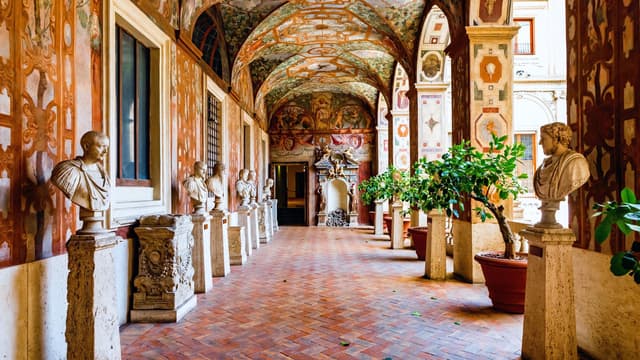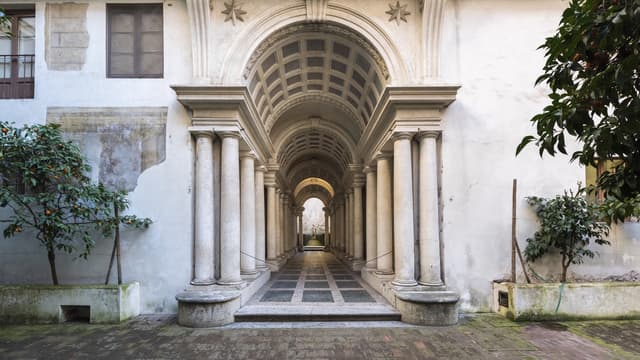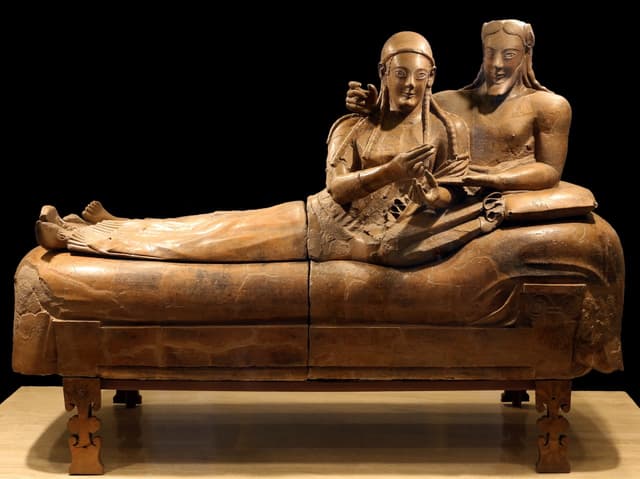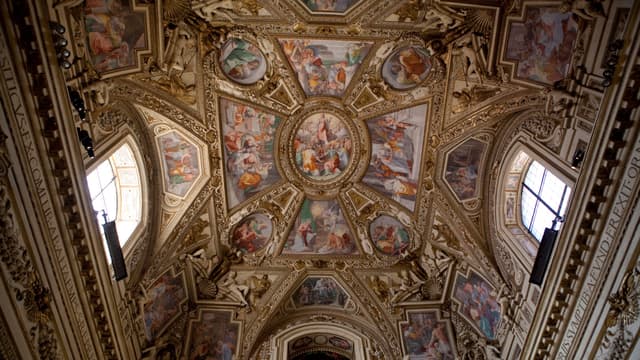Beyond The Vatican: Lesser-Known Spots for Amazing Art in Rome

We are in Rome, the Eternal City, and one of my favorite places on earth.
So let’s start by addressing the big one: The Vatican.
I am a HUGE art history nerd, so I’ve always dreamt of seeing Michelangelo’s ceiling, standing in front of Raphael’s “The School of Athens”, admiring the groundbreaking architectural designs, wandering through the Gregorian Etruscan museum, seeing the Gallery of Maps, etc. And these are all incredible things to see if you have a deep love of art.
There’s absolutely no question that The Vatican is one of the most important historical and cultural sites in the world, but getting in can be pretty treacherous. If you don’t have a pre-purchased ticket, which often sell out months in advance, you could be looking at spending hundreds on a group tour just to get in or a multi-hour wait in the ticket line, and then ANOTHER line just to get through security. Even those with advance tickets end up in a long line, all just to be herded like cattle through the rooms and jostled about with other visitors (up to 20,000 a day!!)
Guess what: you can skip The Vatican.
I know! Heresy! But think of it this way:
You could be spending that crowded, loud day doing something that you’ll really enjoy instead of squeezing through huge tour groups packed like actual sardines into St. Peter’s.
Just because The Vatican is on allll the top-ten lists doesn’t mean you are obligated to go, and you shouldn’t spend your valuable vacation time doing something you may not enjoy just for the sake of crossing it off a list, or taking a photo for Instagram!
I know the FOMO is so, so real, and it can actually feel anxiety-inducing to consider skipping out on such a huge historical site. I mean, most people save up for their Italy trips for years (*raises hand*) and want to see all the “most important” things on this big vacation.
Now, just to be clear, I am NOT saying “Do not go to the Vatican”! If it’s something you’ve always dreamed of, if you’re absolutely dying to see the Sistine Chapel—heck, you don’t need to justify a reason to me or to anyone—then go! It’s an amazing place. What I want to do is just reassure you that skipping the “must-sees” is actually okay, and your trip won’t be any lesser if you choose to do something more aligned with what you want to get out of your vacation.
I also want to provide alternatives to all the tourist hotspots in the hopes that eventually, the crowds will thin, people will travel more with their specific interests and values in focus, and everyone’s trips to Italy will be overall more enjoyable.
As truly one of the most crowded places in all of Italy, the Vatican could definitely use a breather. It’s becoming unsustainable in terms of crowds, and travelers are getting more and more frustrated at how difficult it is to get a ticket or to even just move around, especially in the summer when the tourism peaks and the temperatures are sweltering.
If you love art, Rome is absolutely filled to the brim with it, and you can find some incredible artwork all throughout the city and in much more easily accessible places, if you know where to look. (If you don’t love art and this has convinced you that you can skip the Vatican for that reason alone, keep an eye out for future guides!)
Here are some of my favorite less-visited spots in Rome to experience amazing art, sardineless-ly.
Palazzo Barberini + Galleria Corsini

For a truly impressive collection of Renaissance and Baroque masters from across Europe, you should definitely visit Palazzo Barberini and the Galleria Corsini. Though not located near each other, they are both part of the National Gallery of Ancient Art. These museums feature one of the most important collections of paintings in Italy. Palazzo Barberini’s main hall features a majestic frescoed ceiling by Pietro da Cortona, and two magnificent staircases, one designed by Bernini and one by Borromini.
Artworks here range from the 13th to the 18th century, and encompass a wide variety of the schools of painting and different artistic movements. Some of Palazzo Barberini’s most notable pieces include Caravaggio’s “Judith Beheading Holofernes”, a portrait of King Henry VIII by Hans Holbein the Younger, and Filippo Lippi’s “Annunciation”, along with art from El Greco, Tintoretto, and Titian, to name a few. Additionally, Visitors to Palazzo Barberini until October 27th, 2024, will have the opportunity to see an exhibition of works borrowed from the Galleria Borghese. This is truly one of the most impressive galleries in all of Rome, in my opinion, and shouldn’t be missed!
The Corsini Gallery, on the other hand, features just the collection of the Corsini family, which is impressive in its own right. It remains exhibited in virtually the same exact way the family had displayed their treasures as it was when donated to the Kingdom of Italy (just 20 or so years post-unification) and became Italy’s first national gallery. It holds minor works by artists like Rubens, Caravaggio, and Reni, along with a number of other (mostly Italian) artists, as well as a gorgeous historical library.
If you only have time for one, I’d highly recommend Barberini, but the Corsini Gallery is absolutely worth a visit if you’re in Trastevere or visiting the Villa Farnesina, which is right next door!
The Capitoline Museums

Technically made up of a few different buildings in the same palazzo, this group of museums contains some of the most gorgeous sculptural pieces on display in Rome. They not only house important ancient marble and bronze sculptures, but also jewels, coins, and an impressive collection of busts, including Bernini’s Medusa. The piazza they sit in was designed by Michelangelo in 1536.
Palazzo Nuovo, filled with mostly Ancient Roman artifacts such as statues, mosaics, busts, and sarcophagi, also has a 1st or 2nd-century sculpture of Cupid and Psyche, along with a sculpture of the goddess Venus, from the Antonine Dynasty
The Palazzo dei Conservatori showcases Roman, Greek, and Egyptian statues, including “The Dying Gaul”, as well as the Capitoline Gallery on its third floor which houses its small painting collection where you can see works by Rubens and Caravaggio. The coin and jewelery collections can be found in the attached Palazzo Caffarelli-Clementino. Palazzo Senatorio, another main building, now holds the Roman city hall. Perfect for anyone into ancient art and artifacts.
P.S. Grab an espresso from the Terrazza Caffarelli, the cafe just off the Palazzo dei Conservatori, for an awesome view over central Rome!
Galleria Doria Pamphilj

This museum is somehow an often-overlooked spot that holds the largest private art collection in Rome, with works from artists like Caravaggio, Titian, Raphael, Bernini, Carracci, and a famed portrait of Pope Innocent X by Diego Velázquez. It is one of the most beautifully designed and adorned buildings in the city, with gilded walls, detailed mouldings, and stunning ceilings, along with its impressive collection. It’s just such a gloriously ornate space, and the building is just as splendid as the art it houses! Be sure to check out the chapel as well, which holds the remains of Saint Theodora and the Centurion.
If you’re looking for a collection of some of the true masters of art in an exquisite palace, this is a spot you should definitely make time for!
Chiesa di San Luigi dei Francesi (Church of Saint Louis of the French)

Galleria Borghese

We’ve come to my favorite place in the entirety of Rome, and possibly in the entire world. The Galleria Borghese is an absolutely incredible collection of art, including several sculptures by its most famous artist, Bernini. The Borghese Gallery is located in the middle of the gardens of Villa Borghese. This beautiful park is smack dab in the middle of the city is not only a welcome respite from the bustling streets around it, but it also hosts arguably some of the best art in Italy.
Inside, you’ll see the delicately carved marble masterpieces of Bernini, the most famous featuring Apollo and Daphne at exactly the moment where she cries out to Zeus to save her from Apollo and begins to turn into a juniper tree, The Rape of Proserpina, with the stone looking as soft and supple as human flesh, and Bernini’s interpretation of David as he winds his slingshot back before killing Goliath. These sculptures will quite literally take your breath away (or, if you’re me, weep in front of everyone with no shame).
The museum also showcases a wide selection of paintings by artists like Caravaggio, Raphael, Titian, Veronese, Perugino, and even Rubens, as well as a few other sculptures by Bernini and a depiction of Venus by Canova, Ancient Roman mosaics, and some truly stunning frescoed ceilings that are so worth craning your neck trying to notice every little detail.
Palazzo Massimo alle Terme

For Ancient history fans, Palazzo Massimo should definitely be on your list. Spanning over four floors (basement, ground, first, and 2nd floors), this museum features the most well-preserved Ancient Roman frescoes anywhere in the world and stunning Classical sculptures. The basement floor houses a collection of Ancient coins and jewelry. On the ground and first floors, dedicated mostly to Roman and Greek sculpture (including its most famous, “The Boxer at Rest”), you can also find beautiful mosaics and bronze pieces from two ships that were built to be part of Emperor Caligula’s floating palaces.
Above that live the magnificent frescoes, which come from Villa Livia (one home of Livia, Augustus’ wife) and the original Villa Farnesina from the 1st Century B.C.! This under-appreciated museum gives SUCH a great and thorough depiction of the history of Ancient Rome, walking visitors through different reigns, art and design movements, textiles, mythology etc. Even better, Palazzo Massimo is super easy to access, as it is right next to Termini Station, Rome’s main train station and the one that most visitors enter and leave from. Palazzo Massimo is part of the National Museums of Rome, and you can get a combined ticket for all four sites: Palazzo Massimo, Palazzo Altemps (also highly recommend!), The Baths of Diocletian, and the Balbi Crypt (Temporarily closed for restoration, TBD for reopening date).
Villa Farnesina

Tucked away in the corner of Trastevere, across the river from the central city area, this 16th-century villa holds some gorgeous treasures. You can the stunning Raphael fresco, “The Triumph of Galatea” and his pupils’ depiction of Cupid and Psyche on the loggia ceiling. You can also see various scenes from Ovid’s “Metamorphoses” painted by Sebastiano del Piombo and the Room of the Perspectives, with walls painted to appear as though you were looking outside. A small museum, great for Renaissance and Roman Mythology lovers.
San Pietro in Vincoli

Known as “The Church of Saint Peter in Chains”, this basilica was first built around the year 430 BC. It has been renovated several times since its consecration (I should hope so!), and as such, it features architectural and design aspects of various historical periods, like Doric columns, coffered ceilings, and 7th century mosaics. The church was originally built to house the chains that once imprisoned Saint Peter, which now are on display in the reliquary under the main alter of the church. Its biggest draw, however, comes from Michelangelo’s sculpture of Moses, which is part of the massive (and still unfinished) tomb intended for Pope Julius II. This marble sculpture was completed in 1515 and is about 7.5 feet tall. Unlike most other Roman churches, San Pietro in Vincoli is very simple instead of gilded and ornate, but still beautiful. While not as showy as many other churches, this one should be high on your list, and its proximity to the Colosseum makes it a perfect stop-in to see something completely unique.
National Gallery of Modern and Contemporary Art

If you’re into art that’s just a liiiittle but more modern than the Renaissance/Baroque, this museum might be exactly what you’re looking for. Picking up in the timeline where the Palazzo Barberini leaves off, here you’ll find works spanning from the 1800s through the present day, with pieces from different art movements such as Cubism, Impressionism, Surrealism, etc. Artists like Cezanne, Monet, Van Gogh, Klimt, Pollock, and Mondrian are just a few of the biggest names here. It’s the only museum in the country solely dedicated to modern and contemporary art! It’s a little out of the way on the far side of Villa Borghese from the center of the city, but it will give you more of a classic museum experience vs. a church setting. Highly recommend!
Others worth mentioning (but not expanded upon here or this would take 6 hours to read):
Medieval and Renaissance:


Baroque art:


Ancient art:

Churches:





(Yes, there are a lot of Santa Maria churches! Same Saint, different buildings.)
Contemporary art:




Other:


Happy art hunting!
-Chelsea
*Please check with official sources before your trip for the most up-to-date information on closures, renovations, exhibits, etc.
**Please also only buy tickets from OFFICIAL OR AUTHORIZED SELLERS.
The home for unique & authentic travel